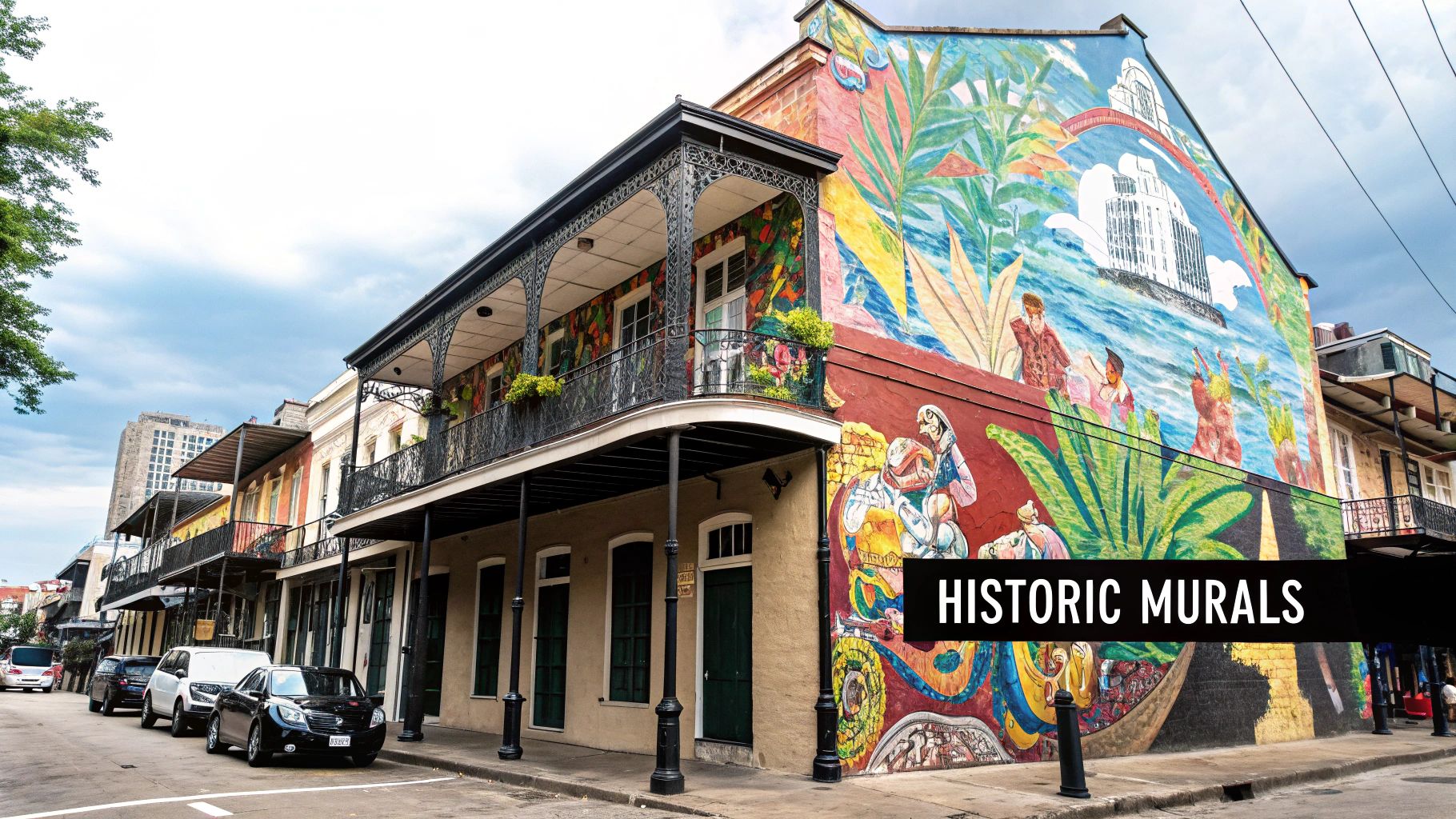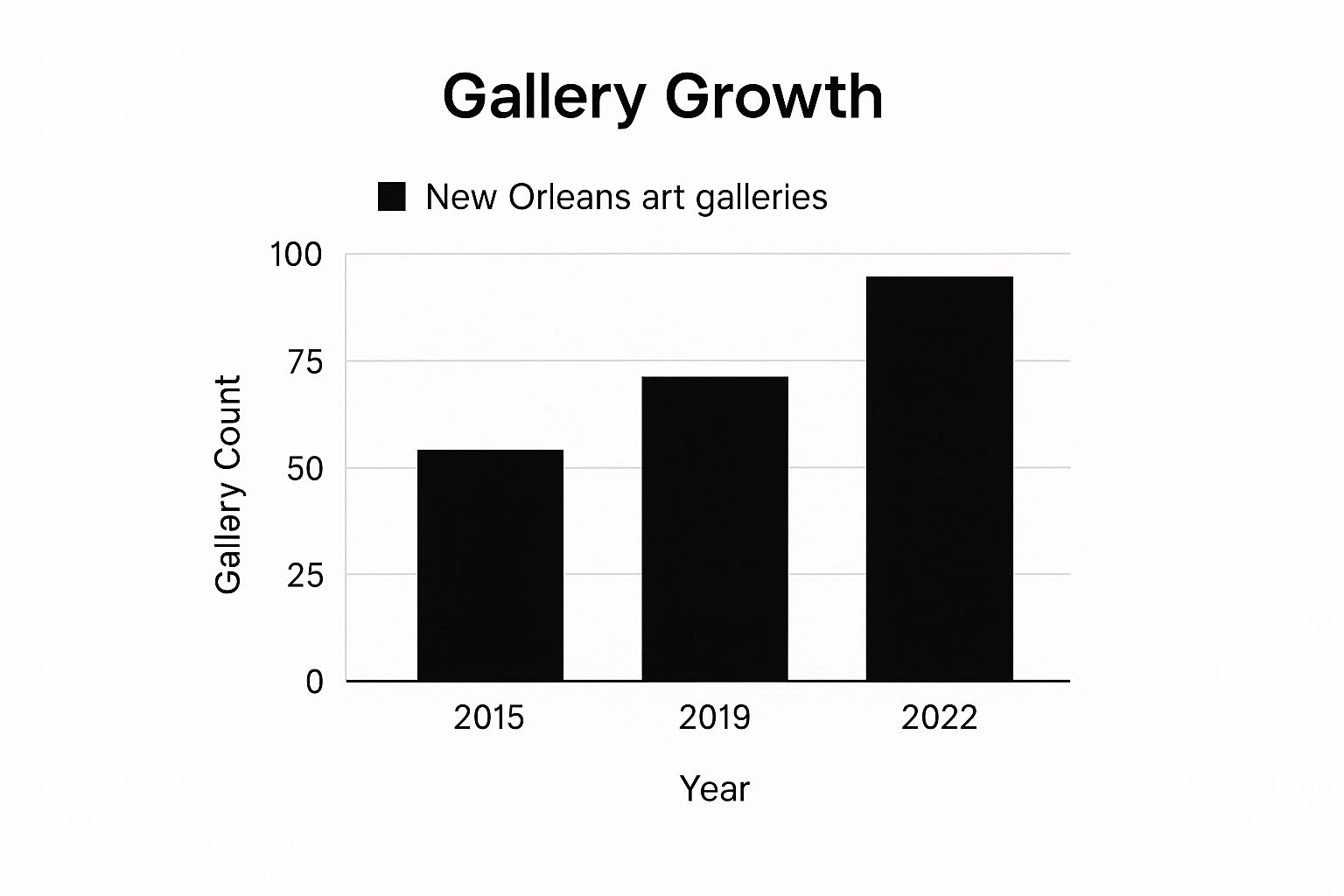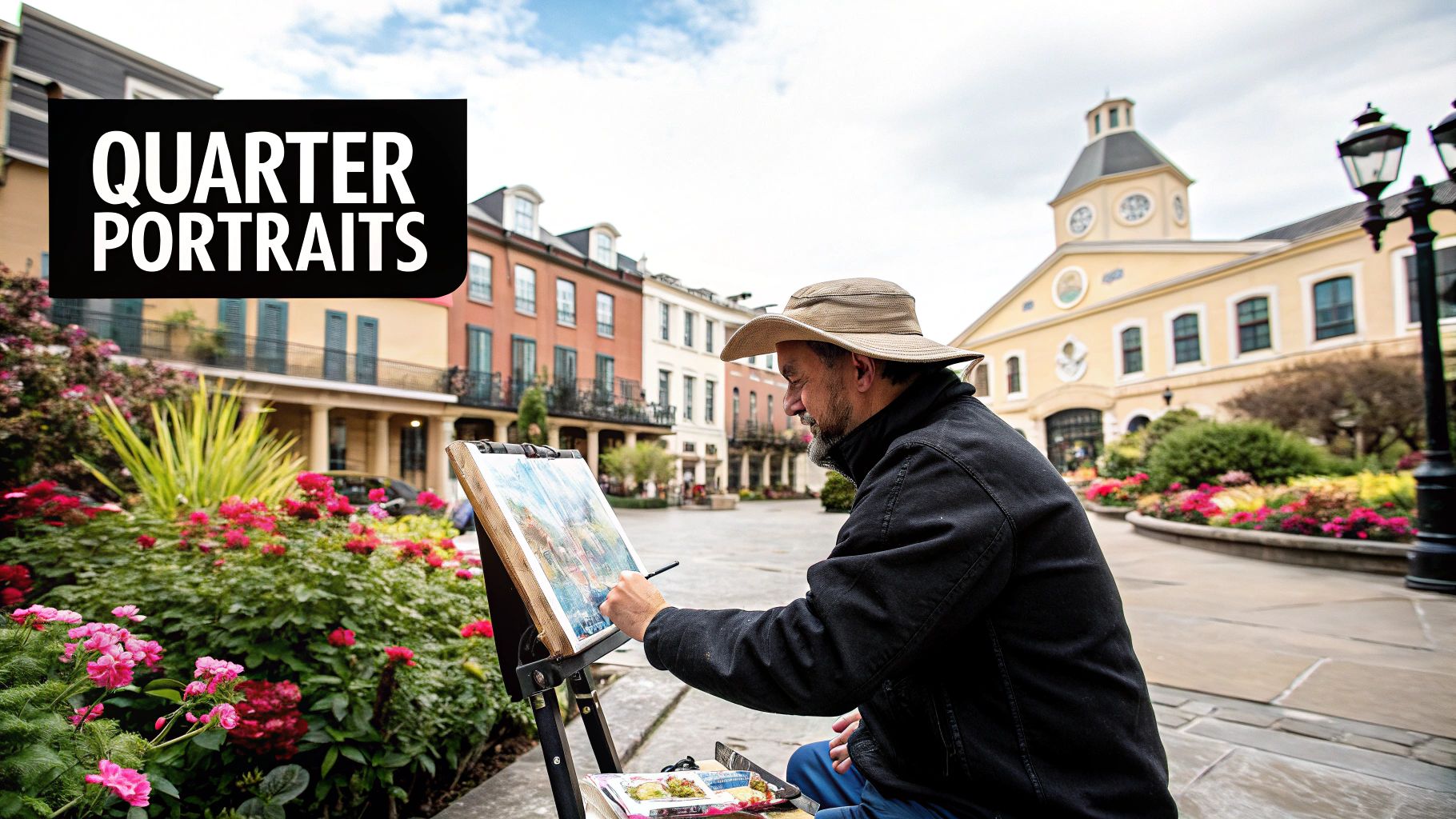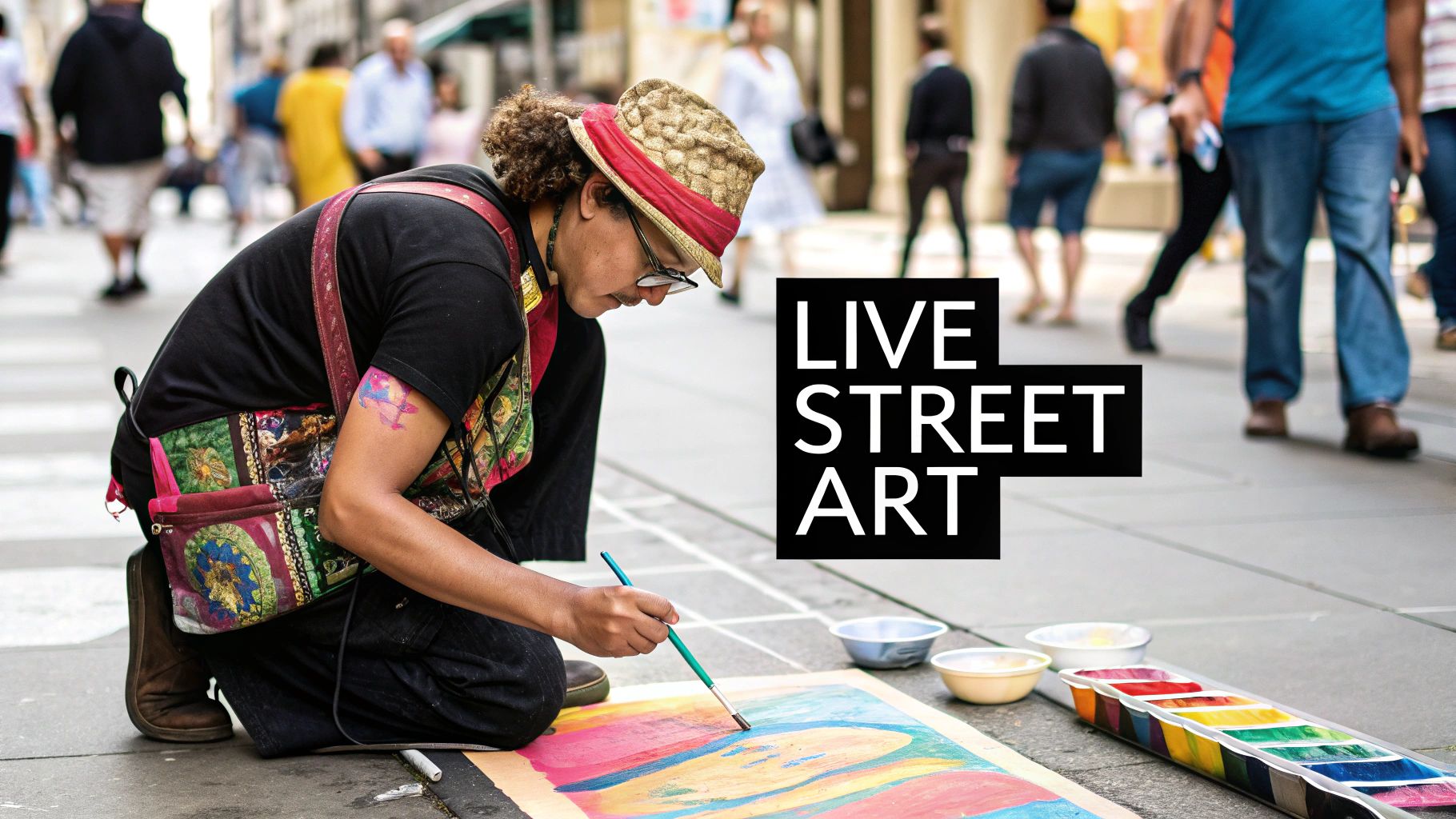When you think about New Orleans, you can practically hear the music and feel the energy. The city's artists are the ones who capture that spirit, translating its wild history, soulful sounds, and incredible resilience into works you can see and feel. From the earliest jazz pioneers to the painters shaping the scene today, their art is completely intertwined with the identity of the Crescent City. To explore their work is to take a deep dive into the very heart of New Orleans.
The Soul of a City Expressed Through Art

In New Orleans, art isn't just something to hang on a wall—it’s the city’s native tongue. It spills out of galleries onto the streets, pours from the bell of a trumpet, and gets woven into the very fabric of every parade and festival. This creative pulse isn't some new trend; it's a legacy built over centuries, nurtured by a mix of cultures you just won't find anywhere else in America.
The city itself is the ultimate muse. Its one-of-a-kind architecture, deep-rooted traditions, and stories of survival offer an endless well of inspiration. For artists here, their work is a direct conversation with their surroundings, a constant dialogue between the past and the present.
The Cultural Crucible
The story of New Orleans art is all about convergence. It’s a place where wildly different traditions bumped into each other, mixed, and created something brand new. You see this most clearly in its most famous export: jazz music. The birth of jazz is the perfect example of this cultural alchemy at work.
Think about places like Congo Square, a historic meeting spot where enslaved Africans blended traditional West African rhythms with Caribbean and European musical styles. That powerful exchange laid the groundwork for a sound that would eventually sweep the globe.
This "melting pot" idea shows up everywhere. You taste it in the food, you feel it during festivals, and you see it most vividly in the work of local artists. They pull from a rich, shared history to create pieces that feel deeply personal yet speak to everyone.
Why It Matters Today
Getting a handle on this history is the key to truly appreciating the artists of New Orleans. Their work isn't just nice to look at; it's a collection of cultural artifacts carrying the weight and joy of the city's entire story. It’s what gives the local art scene such an incredible depth and authenticity.
So, whether you're listening to a brass band lighting up Frenchmen Street or admiring a painting in a Royal Street gallery, you're experiencing a genuine piece of the city's soul. Historians have detailed how these communal musical exchanges directly led to jazz as we know it. You can discover more about how jazz was born in New Orleans from these incredible historical accounts.
Meeting the Founding Fathers of New Orleans Jazz
To really get the creative DNA of New Orleans, you have to go back to where it all started: the music. The city’s entire artistic soul was forged in the fiery, freewheeling world of early jazz. This wasn't just background noise; it was an entirely new American art form being born right on the streets. This was less a quiet evolution and more a vibrant, joyful explosion of sound, all led by a handful of legends we still talk about today.
These foundational New Orleans artists were so much more than just musicians. They were true innovators, taking a wild mix of ragtime, blues, and spirituals and cooking it up into something nobody had ever heard before. In doing so, they created a language that perfectly captured the city's own spirit—unpredictable, soulful, and absolutely bursting with life. Their genius laid the groundwork for every creative who came after, whether in music, painting, or anything in between.
The Architects of a New Sound
Right at the heart of this movement were a few key players whose impact is impossible to overstate. Their names are practically synonymous with jazz itself, and you can still hear their influence in almost every note played in the city.
- Louis "Satchmo" Armstrong: You could argue he's the most important figure in the history of American music, period. Satchmo’s incredible trumpet solos and that famous gravelly voice single-handedly turned jazz from a group effort into a showcase for jaw-dropping individual talent.
- Jelly Roll Morton: A Creole pianist and bandleader with a personality as big as his sound, Morton was one of the very first to actually write down his jazz compositions. He famously (and probably exaggeratedly) claimed he invented jazz back in 1902, but his complex arrangements definitely helped give the new genre a solid structure.
- Kid Ory: This trombonist led one of the most popular bands in the city’s early days. His "tailgate" style—full of bluesy slides and rhythmic counter-melodies—became a signature part of the classic New Orleans sound.
These pioneers didn't just stick to concert halls. Their stage was the entire city. From the rowdy clubs of the Storyville district to the second-line parades snaking through the French Quarter, their music was the living, breathing soundtrack to New Orleans life.
The real magic of these artists was their ability to bottle the city's raw energy and share it with the world. They took the sounds of the street—the joy, the sorrow, the celebration—and turned it into a universal language.
This incredible musical legacy is what put New Orleans on the map as a global cultural hub. It's famous for being the birthplace of jazz, a genre that blended African, Caribbean, and European traditions in the early 20th century. By the 1920s, musicians like Armstrong and Morton had made the city an undeniable force. Satchmo’s groundbreaking Hot Five and Hot Seven recordings, in particular, helped spread the New Orleans sound all over the world. You can dive even deeper into the rich history of New Orleans jazz and its key figures.
Pioneering New Orleans Jazz Musicians
Here’s a quick look at the key contributions of a few early legends who truly defined the New Orleans sound.
| Artist | Primary Instrument | Key Contribution |
|---|---|---|
| Louis Armstrong | Trumpet, Vocals | Popularized the improvised solo, transforming jazz into an art form for individual virtuosity. |
| Jelly Roll Morton | Piano | One of the first great jazz composers, blending ragtime with complex harmonies and structure. |
| Kid Ory | Trombone | Developed the "tailgate" style, a defining feature of the trombone's role in New Orleans jazz. |
| Sidney Bechet | Clarinet, Soprano Sax | Established the saxophone as a major jazz instrument and was a master of powerful improvisation. |
These musicians weren't just playing notes; they were telling the story of their city, a story that continues to inspire artists today.
The infographic below shows just how much the city's commitment to visual arts has grown, building on that strong cultural foundation.

As you can see, the number of gallery spaces literally doubled in just seven years. It’s clear proof that the modern art scene here is not just surviving—it’s thriving.
How New Orleans Artists Influenced the World Stage

The creative energy that boils up from the streets of New Orleans was never going to stay put. Like the Mississippi River it sits on, the city's artistic influence was destined to flow outwards, touching shores far and wide. The sounds, styles, and soul born in the French Quarter and Tremé eventually found their way onto the global stage, carried by the city’s trailblazing cultural ambassadors.
These weren't just musicians exporting songs; they were exporting a feeling. They introduced the world to a whole new way of expressing joy, sorrow, and the simple act of celebration. This cultural exchange is what turned New Orleans from a fascinating regional hub into an international powerhouse whose impact we still feel today.
The Story of a Global Jazz Pioneer
If you want one story that captures this journey, look no further than Sidney Bechet. A Creole prodigy on the clarinet and, later, the soprano saxophone, Bechet was one of the very first true jazz soloists. He was a giant of the art form, with a talent rivaled only by Louis Armstrong. His powerful, vibrato-heavy sound was pure New Orleans, but its appeal was universal.
In the late 1940s, Bechet took a massive leap and moved to France. It was a decision that would not only change his life but alter the course of European jazz forever. He didn't just show up as another musician; he arrived as a phenomenon.
At a Paris festival in 1949, the French audience greeted him with an incredible wave of enthusiasm. They didn't just see him as a visiting artist; they embraced him as one of their own, and Bechet became a national musical icon in his adopted home.
This welcome went far beyond simple applause; it was a deep, heartfelt connection. His most famous recordings from that time, like "Si tu Vois ma Mère," beautifully fused classic French melodies with the unmistakable swing of New Orleans jazz. This hybrid sound kept the tradition alive and helped it flourish on a whole new continent. You can dive deeper into how Dixieland jazz traveled the world on Jazzfuel.com.
An Unbroken Chain of Influence
Bechet’s journey is the perfect case study for how New Orleans artists became unofficial cultural diplomats. They carried the city’s soul in their instrument cases and on their canvases, setting off a ripple effect that touched almost every corner of the art world.
It's a legacy that spread in a few key ways:
- Dixieland and Swing: Artists like Bechet and Armstrong were absolutely critical in introducing these quintessentially American genres to Europe and beyond. They sparked jazz scenes everywhere, from Paris to Tokyo.
- A New Approach to Art: The improvisational, live-in-the-moment spirit of New Orleans music taught the world a lesson: art could be spontaneous, raw, and deeply personal.
- Lasting Cultural Legacy: The incredible success of these early pioneers cemented the city's reputation for good. It forged a permanent link between New Orleans and world-class creativity that still draws new generations of artists to its streets.
From the cobblestones of the French Quarter to the grand concert halls of Europe, the influence of these early masters is impossible to ignore. They didn't just play music—they built a bridge between their home and the rest of the world, a bridge that artists are still crossing to this day.
Exploring the Modern New Orleans Art Scene
Sure, the city's musical legends get a lot of the limelight, but the contemporary visual art scene in New Orleans is every bit as electrifying and crucial to its modern identity. This isn't art that’s locked away in stuffy museums; it's a living, breathing force you can feel pulsing through the city’s creative veins. It tells the story of New Orleans right now—a story of grit, cultural celebration, and an unbreakable spirit.
To really get a feel for this energy, you have to hit the pavement. A great place to start is the Warehouse Arts District, a neighborhood that has completely transformed from industrial storage to a cultural hotspot. Here, you’ll find world-class institutions right next door to edgy, independent galleries, creating a fantastic mix of contemporary work. From there, a walk down the iconic Royal Street in the French Quarter offers something more intimate, with gallery windows full of everything from stunning hyperrealism to bold abstract expressionism.
Themes That Define Today’s Artists
What I find so compelling about modern New Orleans artists is how deeply their work is connected to this place. They aren't just making pretty things to hang on a wall; they are wrestling with and celebrating the city’s complex, beautiful, and sometimes messy story. You'll see a few key themes pop up again and again in their paintings, sculptures, and mixed-media creations.
- Resilience and Rebirth: So many artists are still processing the aftermath of Hurricane Katrina, exploring themes of survival and recovery. Their work often takes symbols of devastation and turns them into powerful statements of hope.
- Cultural Heritage: The city's rich Creole and Cajun roots are an endless well of inspiration. Think vibrant depictions of Mardi Gras Indians, detailed culinary still lifes, and scenes straight out of a second line.
- Architectural Beauty: You can't escape the charm of the city’s ironwork balconies, colorful shotgun houses, and grand Garden District mansions. They’re a constant muse for painters and photographers alike.
These artists are the city’s visual storytellers, translating its soul onto canvas, into clay, or through a camera lens. For a closer look, our guide to the most interesting artists in New Orleans highlights some of the incredible people shaping the scene today.
The modern art scene is a direct reflection of the city’s comeback spirit. After Katrina, the creative community didn’t just rebuild; it exploded with a renewed sense of purpose, using art to process, heal, and celebrate New Orleans’ enduring identity.
This artistic boom isn't just a feeling; you can see it everywhere. The number of galleries in the city has shot up, with new spaces constantly opening to showcase both established names and exciting up-and-comers. This growth ensures that the visual arts remain a vital, evolving part of the city’s cultural conversation, proving that in New Orleans, the past and present are always in a beautiful, creative dance.
Spotlighting a Modern New Orleans Artist

To really get a feel for how the city’s creative DNA pulses through today's art, it helps to zoom in on one artist. Painter William Tucker is a perfect case study, showing how the soul of New Orleans can be captured without ever painting a single, recognizable landmark. His work is a masterclass in abstract expressionism.
Instead of giving you a literal street scene, Tucker translates the city’s raw, unmistakable energy onto the canvas. Think of it like this: you won’t see the delicate ironwork of a French Quarter balcony, but you’ll feel the rhythm of a second-line parade in his dynamic brushstrokes and vibrant color choices. That’s where his art hooks directly into the city's deepest traditions.
The Jazz Connection in Abstract Form
The most powerful thread running through Tucker’s art is its relationship to jazz. That improvisational spirit, the very thing that defines New Orleans music, is alive and well in his painting process. Just as a jazz musician veers off-script with a soul-stirring solo, Tucker takes an intuitive, unplanned approach to layering color and texture.
This connection reveals a core truth about so many New Orleans artists: their work is often less about what the city looks like and more about what it feels like. It’s an art form built on pure emotion and gut instinct, not precise representation.
William Tucker’s art is visual jazz. The canvas is his stage, the paints are his instruments, and the final piece is a performance—a spontaneous expression of the city’s chaotic, beautiful, and soulful rhythm.
This method gives his work a tangible sense of movement and life. His paintings aren't just static images; they're energetic, evolving compositions that practically invite you to find your own story within their layers.
Interpreting Color and Texture
To really appreciate what Tucker is doing, you have to lean into two key elements: bold color and rich texture. These are the tools he uses to tell his story.
- Bold Color Palettes: He often throws intense, contrasting colors together—fiery reds clashing with cool blues or deep purples. This isn't just for show; it’s a mirror of the city's own vibrant chaos and high-energy atmosphere.
- Layered Textures: Get close to his canvases and you'll see it all: thick gobs of paint, scrapes, and drips. This tactile quality gives the work a physical depth, echoing the city's own layered history and gritty, beautiful resilience.
By focusing on these abstract qualities, Tucker manages to capture the true essence of New Orleans. His work is a powerful reminder that the most authentic portraits of a place aren't always the most literal ones.
How to Start Your New Orleans Art Collection
So, you want to bring a piece of the Crescent City home with you? That's a fantastic idea. Starting an art collection can sound a bit daunting, but here in New Orleans, it’s all about a fun, rewarding hunt for something you love. Forget any stuffy rules you've heard. The only thing that matters is finding art that truly speaks to you, whether it’s a tiny print from a new artist or a big, bold piece that stops you in your tracks.
Think of it like a treasure hunt through the city's creative soul. You could start your journey in the open air of Jackson Square, where artists line the fence with their work every single day. It’s a wonderful place to meet creators face-to-face and find an affordable, authentic piece that perfectly captures the city's unmistakable energy.
Finding Your Perfect Piece
Once you start looking, you'll realize art is literally everywhere here. The best way to get a feel for the scene is to check out a few different kinds of places. You'll quickly get a sense of the incredible range New Orleans artists bring to the table.
- Art Markets: Dive into the hustle and bustle of the French Market or the nighttime magic of the Frenchmen Art Market. These spots are goldmines for handmade goods and one-of-a-kind works you can buy straight from the person who made them.
- Artist Studios: If you want a more personal experience, many artists in neighborhoods like the Bywater or the Warehouse Arts District will open their studios by appointment. It’s a rare chance to see where the magic happens and chat with them about their process.
- Prestigious Galleries: Take a stroll down Royal Street. It’s famous for its high-end galleries, which are perfect for finding works from more established contemporary names and even historical artists.
Where to Find Art in New Orleans
To help you navigate your options, here’s a quick breakdown of what to expect from different art venues around the city.
| Venue Type | Best For | Price Range |
|---|---|---|
| Street Artists (Jackson Sq.) | Iconic NOLA scenes, affordable prints, and direct artist interaction. | $-$$ |
| Art Markets (Frenchmen/French) | Unique crafts, emerging artists, and a lively, informal atmosphere. | $-$$ |
| Co-op & Independent Galleries | Discovering new local talent and a diverse range of contemporary styles. | $$-$$$ |
| Royal Street Galleries | Investment pieces, established artists, and high-end fine art. | $$$-$$$$ |
Each venue offers a completely different vibe, so don't be afraid to wander and see where the city takes you. The perfect piece is out there waiting.
Before you pull the trigger on a purchase, pause and connect with the story behind it. Ask the artist or gallerist about their inspiration, their technique, or what the piece personally means. Art becomes infinitely more special when you know the heart and soul that went into creating it.
Following this path turns you from just a buyer into a genuine collector—someone who not only finds beautiful things but also supports the local creative community and forges a real connection with the city’s culture. Exploring the incredible diversity of New Orleans art for sale is the first, most exciting step in finding something you’ll cherish forever. This is how you start building a collection with meaning.
Your Questions About New Orleans Artists Answered
Stepping into the New Orleans art scene is an incredible experience, but it can also bring up a lot of questions. If you're wondering what makes the art here so special or where to even begin, you're not alone. Let's tackle some of the most common questions people have.
What Makes New Orleans Art So Unique?
What sets New Orleans art apart is that it’s impossible to separate from the city itself. The art isn't just made in New Orleans; it's practically breathing the city's air. You’ll see the city's soul reflected in everything—from the vibrant chaos of a Mardi Gras parade and the improvisational spirit of a jazz riff to the quiet resilience of its historic neighborhoods.
This deep, authentic connection to place gives the art a kind of spirit you just won't find anywhere else. It’s raw, soulful, and completely genuine.
Who Are Some Famous Contemporary Artists?
While the city has its historical legends, today's art scene is absolutely electric with talent. If you're looking for artists who are making waves right now, here are a few names you need to know:
- Dr. Bob: You can't miss his colorful, quirky folk art. His famous slogan, "Be Nice or Leave!," has become a local mantra.
- Terrance Osborne: His paintings are a burst of energy, capturing the city’s lively street scenes and celebrations with incredibly brilliant colors.
- Brandan 'Bmike' Odums: A powerful voice in the community, Bmike creates massive murals and installations that tell crucial stories about Black history and social justice.
- William Tucker: His work taps into the very essence of jazz, translating its improvisational energy into bold, textured abstract expressionist paintings.
The best way to find your next favorite artist? Just wander. Spend an afternoon exploring the galleries in the Warehouse Arts District or strolling down Royal Street. You never know what you'll discover.
The most meaningful way to support the local scene is to buy directly from New Orleans artists. When you visit an art market, show up for a gallery opening, or buy a piece from a local shop, you're helping keep this incredible culture alive.
And it doesn't always have to be about buying. Sharing an artist's work on social media or just telling a friend about someone you discovered makes a real difference. It’s that kind of support that ensures this one-of-a-kind creative community will be here for generations to come.
At William Tucker Art, we're all about celebrating the vibrant, untamed spirit of New Orleans. See how William's abstract expressionism and wildlife portraits bottle that magic by exploring his collections online.
